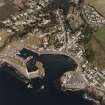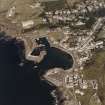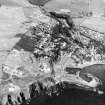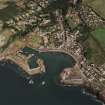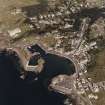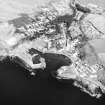Portpatrick, St Patrick Street, Old Parish Church
Burial Ground (18th Century), Church (17th Century), Dovecot (Period Unknown)
Site Name Portpatrick, St Patrick Street, Old Parish Church
Classification Burial Ground (18th Century), Church (17th Century), Dovecot (Period Unknown)
Alternative Name(s) Portpatrick Old Churchyard; Saint Andrew's Kirk
Canmore ID 60334
Site Number NW95SE 1
NGR NW 99976 54212
Datum OSGB36 - NGR
Permalink http://canmore.org.uk/site/60334
- Council Dumfries And Galloway
- Parish Portpatrick
- Former Region Dumfries And Galloway
- Former District Wigtown
- Former County Wigtownshire
NW95SE 1 99976 54212
For successor and present parish church (NX 0015 5440), see NX05SW 31.
For shale discs found in Portpatrick (Old) Churchyard, see NW95SE 2.
(NW 9998 5421) Church (NR) (In Ruins)
OS 25" map (1909)
The ruins of the old parish church of Portpatrick are cruciform in plan and bear the dates 1622 and 1629. It measures 63'6"E-W, excluding the tower, and 24'10" N-S, over walls 3'3"-3'9" thick. The west end of the church is separated from the other parts by a crosswall, probably a later erection.
The circular tower is four-storeys high with a steep slate roof, apparently modern. It seems to have been erected originally as a watch tower, or possibly in connection with an older church which was removed to make way for the existing building in the 17th c.
The church is now roofless and neglected and the tower is used as a dovecot. The interior of the church and the surrounding churchyard are a mass of tangled vegetation. This church replaces a pre-Reformation chapel, called Chapel Patrick, dedicated to that saint, and was itself replaced in 1842, by a church built elsewhere.
RCAHMS 1912, visited 1911; H Scott 1917
As described by RCAHMS.
Visited by OS (WDJ) 1 September 1970
This church, now a roofless ruin, is cruciform on plan and incorporates a four-storeyed round tower on the W. It measures 17.3m from E to W by 5.8m transversely, and 14.6m from N to S by 5.8m transversely, within walls 0.9m thick; there is a blocked S door to the S aisle and the fabric of the building incorporates a number of moulded stones in re-use. The tower (2.8m in diameter within a wall 1.1m thick) appears to antedate the church and may originally have been free standing; it possibly served both as a navigational beacon and as a belfry. The church was built in 1629 (date on skewput), possibly on the site of a chapel dedicated to St Patrick, and was abandoned in 1842 on the completion of a new parish church (NW 0014 5442). Forty-two shale discs, probably prehistoric in date, were found in the burial-ground; some are now in the National Museum of Antiquities of Scotland (FN 62-79, 81-96, 148-151) while others are in Stranraer Museum (1968 MW 13).
NSA 1845; D MacGibbon and T Ross 1887-92; W Macfarlane 1906-8; RCAHMS 1912; H Scott 1915-61; G Hay 1957; H Dixon, K Kenmuir and J Kennet 1977; RCAHMS 1985, visited July 1984.
Roofless rubble cruciform kirk built in 1628-9; the date 1629 is incised on a skewputt of the chancel. Rectangular windows, their mullions removed in 1791.
J Gifford 1996.
NMRS REFERENCE:
Scottish Record Office:
Rebuilding of the decayed Kirk.
Extract Act of the Synod of Galloway for rebuilding the decayed Kirk at Portpatrick, with a letter to Sir William Alexander, requesting the King to make the surrounding lands its parish.
1626 GD 214/502
Publication Account (1986)
The four-stage circular tower of this ruinous church is conspicuous in the centre of Portpatrick, and was probably designed to serve both as a belfry and navigational beacon for the early harbour (no. 1). The shell of the church to which it is attached is of an equal-anned crucifonn plan, and is dated on the gable skewput (the lowest stone), 1629; a screen-wall was subsequently built across the western aisle to fonn a T-plan interior. The church was lit by lintelled and mullioned windows in each of the three gables, and above them on the outer walls are spaces for carved panels. Moulded fragments, possibly from a medieval chapel on this site, have been reused in the building fabric. Prior to the current scheme of restoration and consolidation, the tower was repaired in about 1880, and the church last used for worship in 1842 when the present parish church was built.
Some of the tombstones in the burial-ground commemorate the maritime tragedies which have beset Portpatrick, the most poignant perhaps being that to the fifty victims of the wrecked steamship, Orion, in 1850.
Information from ‘Exploring Scotland’s Heritage: Dumfries and Galloway’, (1986).























































